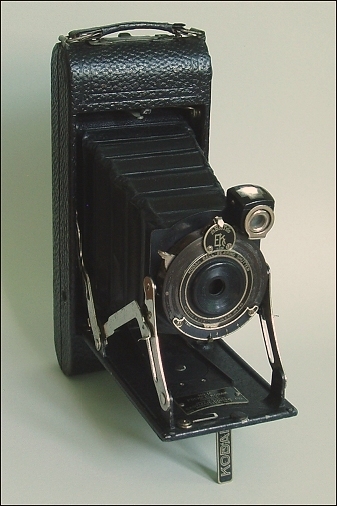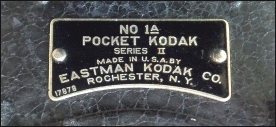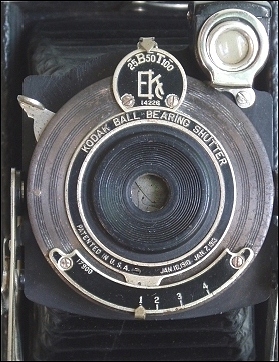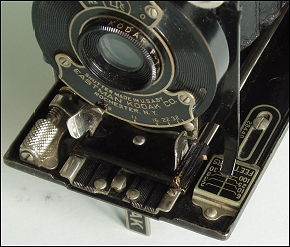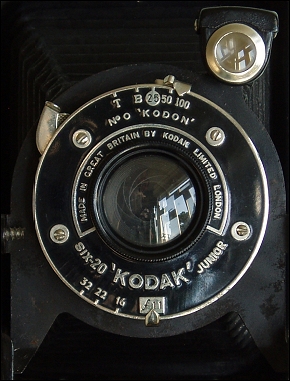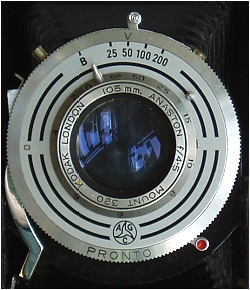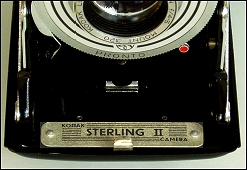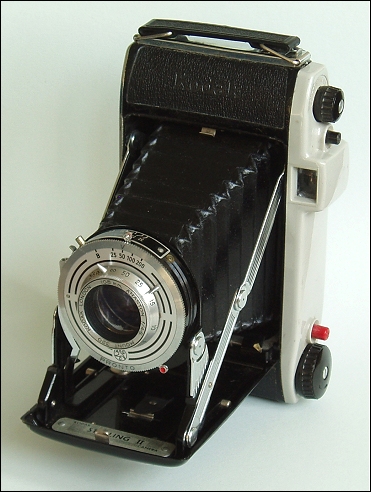This
Kodak Sterling II (apparently there was no Sterling I) was
manufactured between 1954 and 1959. Because of the black knobs this
particular camera can be dated between 1954 and mid 1956. It
uses 620 roll film.
This
camera is much rarer than the similar 'Junior I' and 'Junior II' which look
almost identical but definitely are not. This camera sports an f4.5
/ 105mm Anaston lens and Pronto shutter.
The
shutter has to be manually cocked before it is released and can be timed
using the red lever situated below the lens. It's highest speed is 1
/ 200th second.
Vest Pocket
Kodak Series III

Pocket Kodak No1A Series II


Front view showing shutter and
aperture controls
Rack and pinion
focusing arrangement
Manufactured in
the USA from the late 1920's until about 1936. As its name suggests
this camera is much smaller than the Pocket Kodak No.1. When folded it is
about 50% larger than a packet of cigarettes.
This simple
non-autographic folding camera was manufactured between 1935 and 1937. As
it's name implies it used type 620 roll film giving eight exposures with a
frame size of 6cm x 9cm.
The lens is a
fixed focus f11 Kodak doublet relying on it's small aperture to give an
acceptable depth of field. The marked apertures are f11, f16, f22 and f32.
The shutter is a No. 0 'Kodon' offering speeds of 1/25, 1/50 and 1/100th
sec. together with T and B.

Because of the
slow film speeds available at the time, and the need for small apertures to
keep everything in focus, the maximum shutter speed is 1/100 sec. 1/25th and
1/50th sec. are also offered as are B (Brief/Bulb) and T (Timed).
The aperture
stops are simply labeled 1 to 4 which seem to correspond to f11, f16, f22
and f32. Type 116 film was used giving an image size of 2¼" x 3¼",
sufficiently large enough to be viewed without the need for enlargement.
Like many folding
cameras of this vintage it is autographic, the stylus being clipped to the
back of the camera alongside the handle.
This camera was made
in the USA by Eastman Kodak between 1914 and the mid 1920's.
It was made for the
lower end of the market and has very limited functionality.
It has a fixed focus
lens and a ball bearing shutter.
The simple meniscus
achromatic lens has a focal length of about 5" and is situated behind the
shutter as can be seen here.
Because of the lack
of a focusing control the camera relied on a small lens aperture to keep
everything from about 10' to infinity in reasonable focus.
This
relatively small autographic folding camera was available in the UK between 1931 and
1937. It used smaller type 127 roll film but was limited to only 8
shots per roll. The image size was 1⅝" x 2½".
The autographic stylus can be seen parked alongside the shutter release.
It employs a
Kodar f7.9, 86mm lens and a Kodex No. 0 shutter with speeds of 1/25th
and 1/50th of a second together with B and T settings. Apertures
can be set between f7.9 and f32.
Because of
its small size and its ability to fit inside a handbag, this camera was
also available in blue, brown, green, grey and red (together with a
matching satin lined 'clamshell' case and advertised as "The Modern
Camera for the Modern Girl".
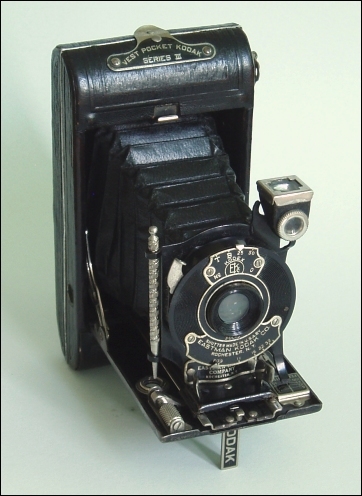

It is interesting
to note that, although being of the traditional folding bellows type, this
camera makes use of plastics. The waist level reflex viewfinder has
been abandoned and has been replaced by an eye level viewfinder.
